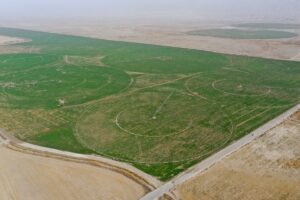 Pin
Pin Long before the Angles, Saxons and Jutes or English, as we might call them, came to Britain as invaders and settlers, the Britons were Christians. They had learned the faith from their Roman conquerors as the Romans themselves became slowly and steadily converted to Christianity.
Indeed, after the Roman Emperor Constantine proclaimed himself a Christian and persecution ceased, the new faith flourished in Britain, and in A.D. 314 we find that three British bishops attended a great council of the Church summoned by the Emperor at Arles in France.
All this was soon to change as the Romans withdrew from Britain and the invading English took over. The new immigrants disliked Christianity, which they regarded as a religion of the hated Romans. They seem to have exterminated it completely except in those wild western parts of the islands to which they drove the fugitive Britons.
In place of Christ, the gods Odin and Thor were worshipped. War was now a virtue, and peace a vice. The English chieftains fought each other and when they took prisoners in battle they sold them as slaves to foreign lands.
Thus it happened that some English boys were one day being offered for sale in the slave market at Rome when a priest named Gregory came by.
Noting the fairness of their complexion, which made them look very different from brown-skinned, dark-haired Italian boys, Gregory asked, “Are they Christians or Heathens?”
“Heathens,” he was told.
“From which land are they?”
“They are Angles, sir.”
“Not Angles, replied Gregory, “but angels, for that is what they would be in the kingdom of heaven.”
Some years later Gregory was elected Pope, and, remembering the Angles in the slave market, he despatched a friend of his, a Benedictine Monk named Augustine, to preach Christianity to the English.
With a handful of missionaries to help him, Augustine set out for Britain. But on the journey through Gaul (modern France) the missionaries became panic-stricken about the dangers ahead. Augustine then wrote to Pope Gregory asking if the missionaries could be allowed to go home again.
The letter that Gregory sent back must have been a noble and inspiring one. It urged the missionaries not to give up, but to go forward in faith. And, without further demur, they continued their journey.
Crossing the Channel, they landed at Ebbsfleet, near Ramsgate in Kent, then part of the realm of Ethelbert, the great King of Kent. The choice of landing place was an intelligent one, for although Ethelbert was a heathen, he had married a Christian princess from Gaul, Bertha, and it was thought that he might at least be sympathetic to Augustine and his missionaries.
“We have come from Rome to bring you and your people a joyful message.” Augustine wrote to Ethelbert. “All who believe our words will be assured of heaven and happiness.”
“Stay where you are for the moment,” the King wrote back. “You will be furnished with everything necessary for your comfort while I decide what to do with you.”
Some days later Ethelbert visited Augustine and invited him to speak. He took the precaution of sitting in the open air, on the chalky downs within sight of the sea, believing that the magical arts that would be practised by the visitors would be less powerful than inside a building.
 Pin
Pin Augustine, sent from Rome to preach Christianity to the Britons, addresses the heathen Ethelbert, King of Kent and his Christian wife Bertha who came from Gaul (now called France).
Historic sermon
The missionaries prayed, sang the litany and held up a silver cross and a picture of the Crucifixion painted on a board. Then Augustine preached to the King. Out on the grassy cliff-top, against the sound of the rolling waves, it must rate as the most momentous sermon ever preached in Britain.
At the end of it Ethelbert gave his opinion:
“Your words and promises are very fair, but as they are all new to us, and of uncertain import, I cannot approve of them so far as to forsake that which I have so long followed with the whole English nation.”
“But because you have come from afar into my kingdom and wish to impart to us those things which you believe to be true and beneficial, we will not molest you, but give you favourable entertainment… Nor do we forbid you to preach and gain as many converts as you can.”
The King. who must be given full marks for kindliness and tolerance, then invited his Christian visitors to go and live in Canterbury, the chief town of his kingdom. In that town there was the little church of St. Martin’s, built long before by Roman Christians, where Queen Bertha prayed and to where, in due time, came potential converts, attracted by the simple, honest lives of Augustine and his missionaries.
Soon the conversions began to multiply very rapidly. The King himself became a Christian and on one day, in the River Swale, ten thousand of his people were immersed two by two, performing the baptism on each other at the command of Augustine.
Pope Gregory was delighted with the success of his mission. He made Augustine Bishop of Canterbury, and ever since then the Bishop, or Archbishop, of Canterbury, has been the leader of the English Church.
But the Pope wanted the work extended beyond Kent, and Augustine sent missionaries into Essex. One of them, Justus, was. consecrated Bishop of Rochester and another, Mellitus, Bishop of London. As a result of their work, the East Saxon King Sabert and many of his people became Christians.
With King Sabert’s approval, Ethelbert founded a church, dedicated to St, Paul, in London, and the dome of the great . cathedral built in later days still looks down from the same site upon that city.
Gradually, the Christian missionaries made their way right across England. Frequently they met setbacks. Even Kent returned to heathenism for a time after Ethelbert’s death. The last part of England to accept Christianity was East Anglia, an within a hundred years of the coming of St. Augustine, the whole country was Christian.
Sometimes the motives for becoming Christian were not always good. Edwin King of Northumbria, married Ethelbert’s daughter, and was sympathetic to his wife’s faith. He was inclined to think it might have helped him escape from an assassin’s knife and to win an important battle.
But he called his Council together and asked their views.
Coifi, the chief heathen priest, thought it was time for a change, because he had gained little reward from the heathen gods.
Another of the councillors likened the life of a man to the flight of a sparrow through the King’s palace. “While he is within he is safe from the wintry storm, but after a short space of fair weather he immediately vanishes out of your sight into the dark winter. So this life of a man appears for a short space, but of what went before, or what is to follow, we are utterly ignorant.”
At this King Edwin declared himself a Christian. And to indicate that no one need fear any retribution from the old gods, Coifi hurled his spear at the chief heathen temple.
The watching crowd expected something terrible to happen, but when the heathen idols proved incapable of defending themselves, the people surged forward and temple and idols were burned to the ground.
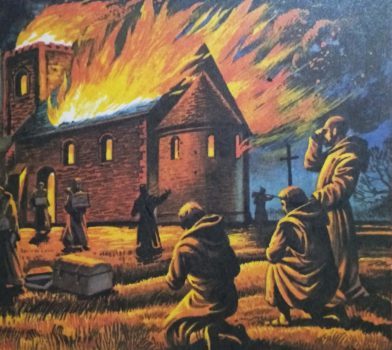 Pin
Pin ORIGINS OF THE CATHEDRAL
When William the Conqueror came from Normandy to England in 1066, the Saxon cathedral in Kent was still intact. It had been built on the site of a chapel founded by St. Augustine in the sixth century. However, the Saxon cathedral and King Canute’s crown which was kept there were destroyed by fire in 1067. Rebuilding began under Lanfranc, the first Norman archbishop, conscecrated in 1070, and one of the greatest men ever to sit in the Chair of St. Augustine, the primate’s throne. Lanfranc’s cathedral was badly damaged by fire in 1174 but parts of it exist within today’s building. The present Canterbury Cathedral was begun in 1174 and completed in 1495.
 Pin
Pin THE OLDEST ENGLISH CHURCH LIBRARY
The Cathedral library began as a collection of illuminated manuscripts formed by Augustine monks in 597. It is now the oldest library of religious books in the English-speaking world. Throughout the Cathedral’s chequered history, the collection of books has been depleted on occasions by fires or raiders, as in the Civil War period of the 1640s, only to be built up again by kind benefactors such as Archbishop Juxon who built a handsome new library after the restoration of the monarchy in 1660, A later library, created from a Norman dormitory built in Lanfranc’s day, was bombed out of existence during the Second World War.
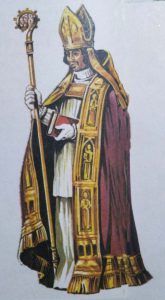 Pin
Pin An Archbishop of Canterbury in his ceremonial robes. His hat is called a ‘mitre’, his cloak a ‘chasuble’ and his staff a ‘crosier’.
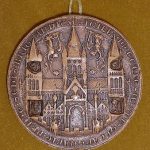 Pin
Pin The common seal of Canterbury Cathedral used on official church documents until the reign of Henry VIII (1509-1547). Then, the Church in England broke away from the Roman Catholic Church and a new seal was made for the cathedral.
CANTERBURY CATHEDRAL
Founded by St. Augustine fourteen centuries ago, Canterbury Cathedral has survived its sometimes turbulent history to become the Church of England’s foremost place of worship. Within its walls are the tombs of many famous people: Archbishop Stephen Langton, who joined the nobles in forcing King John to sign the Magna Carta at Runnymede in 1215; Edward, the Black Prince, who led the English army to victory over the French at Crecy in 1346; and King Henry IV who died in 1413, just two years before his more famous son and heir, Henry V, led the English to victory over the French at Agincourt. The place of the Martyrdom and St. Thomas’s Shrine are dedicated to the memory of Thomas Becket, the Archbishop murdered in the cathedral in 1170. St Anselm’s Chapel commemorates the former archbishop of 1093 while the Warriors’ Chapel is the shrine of the East Kent Regiment where its badge, colours and roll of honour are kept.
 Pin
Pin 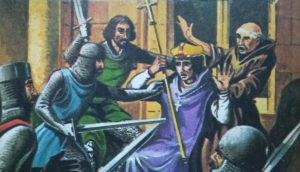 Pin
Pin On December 29, 1170, the Archbishop of Canterbury, Thomas Becket was murdered in the Cathedral by four knights who thought they were carrying out the wishes of Henry Il (shown above). The king had passed some laws limiting the powers of the Church and Becket had refused to obey them.
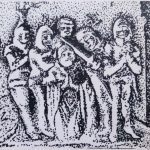 Pin
Pin The murder of Becket, depicted on cloister roof.
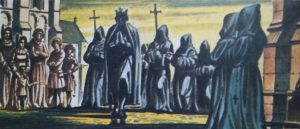

The Pope made Henry II do penance for Becket’s murder, holding him responsible for it. Becket was made a saint and his shrine attracted many pilgrims. Geoffrey Chaucer’s Canterbury Tales’ were written about such pilgnms.
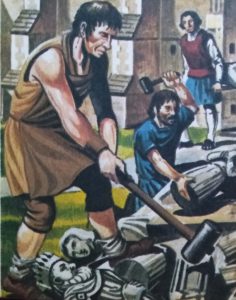 Pin
Pin During the Reformation, Becket’s shrine was destroyed by order of Henry VIII, but the tragic story of perhaps England’s most famous martyr lived on and to this day it attracts many visitors to Canterbury Cathedral.
Canterbury Cathedral stands as a testament to faith, history, and architectural excellence
Canterbury Cathedral, located in Canterbury, Kent, England, is one of the most iconic and significant religious sites in the country. It is the seat of the Archbishop of Canterbury, the leader of the Church of England and the head of the worldwide Anglican Communion. The cathedral attracts thousands of pilgrims and visitors each year, seeking to explore its rich history, stunning architecture, and religious significance.
The history of Canterbury Cathedral dates back to the 6th century when Saint Augustine, the first Archbishop of Canterbury, established a Christian church on the site in the year 597 AD. Over the centuries, the cathedral has undergone several transformations, expansions, and renovations, resulting in the magnificent structure we see today.
The architecture of Canterbury Cathedral is a melange of various styles, reflecting the different eras and influences that shaped it. The majority of the cathedral’s structure is in the Gothic style, specifically Early English and Perpendicular Gothic architecture. The building features soaring pointed arches, ribbed vaults, and intricate tracery, all typical characteristics of the Gothic period. The iconic central tower rises to a height of 235 feet, making it one of the tallest in England.
One of the most renowned parts of Canterbury Cathedral is the Trinity Chapel. Located at the eastern end of the cathedral, this chapel is considered a masterpiece of medieval architecture. It houses the Shrine of Saint Thomas Becket, a significant Christian martyr who was Archbishop of Canterbury in the 12th century. The shrine attracts pilgrims from all over the world, who come to pay their respects and seek solace in the presence of this important religious figure.
Visitors to Canterbury Cathedral can also explore the stunning nave, which stretches for over 180 feet and is adorned with beautiful stained glass windows. The cathedral’s stained glass is particularly noteworthy, as it features pieces from different periods, showcasing the evolution of stained glass art over the centuries. These windows depict various biblical scenes, saints, and historical events, providing visitors with a visual journey through Christianity’s rich heritage.
The cloisters of Canterbury Cathedral are also a must-see. These covered walkways, which surround an open courtyard, are a peaceful and serene area within the cathedral. They provide a place for contemplation and reflection, away from the bustling crowds and noise outside. The cloisters’ arches and carvings are a testament to the skills of medieval craftsmen and offer visitors a glimpse into the architectural beauty of the past.
Aside from its architectural wonders, Canterbury Cathedral is also renowned for its musical heritage. The cathedral has a long tradition of choral music, and its choir is widely regarded as one of the best in the world. The glorious sound of the choir singing within the cathedral’s hallowed halls adds to the spiritual ambiance and leaves visitors with a lasting impression.
In addition to its religious significance, Canterbury Cathedral holds immense historic and cultural importance. It is a UNESCO World Heritage Site, recognized for its outstanding universal value as an architectural masterpiece and for its association with the development of Christianity in England. The cathedral’s connection to Thomas Becket and the Canterbury Tales by Geoffrey Chaucer further solidify its place in English literary and historical heritage.
Canterbury Cathedral stands as a testament to faith, history, and architectural excellence. Its awe-inspiring structure, religious significance, and cultural and historical importance make it a must-visit destination for pilgrims, history enthusiasts, and anyone seeking to encounter the beauty and spirituality of this iconic religious site.
Canterbury Cathedral is a magnificent example of Gothic architecture and has a rich history dating back over 1,400 years. Here are some of its key architectural features and unique elements:
These are just a few of the architectural features and unique elements that make Canterbury Cathedral a remarkable religious and cultural site.
Canterbury Cathedral is of immense historical significance and has played a vital role in shaping English religious and cultural heritage. Here are some key aspects of its historical significance:
Canterbury Cathedral’s historical significance lies in its foundational role in English Christianity, the martyrdom of Thomas Becket, its influence on literature, its function as a center of power, its architectural importance, and its recognition as a UNESCO World Heritage Site. Together, these factors have contributed to shaping English religious and cultural heritage for centuries.
Canterbury Cathedral holds significant importance in the Anglican Church as it is the mother church of the worldwide Anglican Communion. It holds the seat of the Archbishop of Canterbury, who is considered the spiritual leader of the Anglican Communion and the symbolic head of the global Anglican Church.
The cathedral has a rich history and holds great religious significance. It is the site where Thomas Becket, the Archbishop of Canterbury, was martyred in 1170, and his shrine became a popular pilgrimage destination throughout the medieval period. The martyrdom of Thomas Becket at Canterbury Cathedral was seen as a challenge to the power of the monarchy and the subsequent canonization of Becket elevated the cathedral’s importance.
Pilgrimage to Canterbury Cathedral has been a tradition dating back to the Middle Ages and has continued to play a significant role in the Anglican Church and broader Christian pilgrimage traditions. It is associated with the pilgrimage described in Geoffrey Chaucer’s famous literary work, “The Canterbury Tales,” where a group of pilgrims journey to the cathedral. People from around the world still undertake pilgrimages to Canterbury Cathedral, seeking spiritual solace, historical connection, and the experience of walking in the footsteps of countless pilgrims who have visited before them.
Canterbury Cathedral holds a unique position in the Anglican Church as the mother church of the Anglican Communion and a vital spiritual destination for pilgrims. It serves as a place of worship, a symbol of religious authority, and a reminder of the enduring spiritual traditions of the Anglican faith.
Frequently Asked Questions : Canterbury Cathedral
Canterbury Cathedral is a historic Christian church located in Canterbury, England. It is one of the oldest and most renowned cathedrals in the world, serving as the seat of the Archbishop of Canterbury, the leader of the Church of England.
The original cathedral was founded in the year 597 by St. Augustine, but the current structure dates back to the 11th century. The cathedral has since gone through various restoration and expansion projects over the centuries.
Canterbury Cathedral holds immense historical and religious significance. It is the site where Thomas Becket, the Archbishop of Canterbury, was martyred in 1170, making it a popular pilgrimage destination. The cathedral also played a pivotal role in the development of Christianity in England and has been the center of numerous important religious and political events.
The opening hours vary throughout the year. Generally, the cathedral is open to visitors from 9:00 am to 5:30 pm, Monday to Saturday. On Sundays, it opens after 12:30 pm following services until 3:00 pm. However, it is best to check their official website or contact their visitor information center for the most up-to-date opening hours.
Yes, entry to Canterbury Cathedral requires an admission fee. The current prices can be obtained from the official website or the visitor information center. The ticket price also includes access to the crypt, nave, and parts of the precincts. Additional charges may apply for access to the tower, library, or other special exhibitions.
Yes, Canterbury Cathedral is primarily a place of worship. Daily services, including morning and evening prayer, Holy Communion, and Evensong, are open to the public and visitors are welcome to attend. However, it is recommended to check the service schedule in advance, as some areas may be temporarily closed off during certain services.
Yes, guided tours led by knowledgeable staff members or volunteers are available to enhance your visit. These tours provide valuable insights into the history, architecture, and significance of the cathedral. Additionally, there are options for private guided tours and special tours focused on specific themes or areas of interest.
Tower tours are occasionally offered, allowing visitors to climb the spiral staircase and enjoy panoramic views of the city of Canterbury and the surrounding area. However, access to the tower may be limited during certain times or weather conditions. It is advisable to check with the visitor information center or the cathedral’s website for the availability of tower tours on the day of your visit.
Yes, Canterbury Cathedral is accessible to wheelchair users and those with limited mobility. There are ramps at the entrance, and accessible toilets and elevators are available in designated areas. Wheelchairs may also be borrowed from the visitor center, subject to availability. However, certain areas of the cathedral may have restricted access due to their historical nature and architectural features.
Photography is generally allowed within the cathedral for personal use, but restrictions may apply in certain areas or during specific events or services. Flash photography and tripods are not allowed, and it is important to respect the privacy of other visitors and religious ceremonies.
Yes, visitors can explore the beautiful cloisters, which are covered walkways connecting different areas of the cathedral. The cloisters lead to the stunning gardens where visitors can relax and appreciate the tranquil surroundings. The gardens are meticulously maintained and offer a picturesque setting for a leisurely stroll or contemplation.
Yes, there is a gift shop that offers a wide variety of souvenirs, religious items, books, and crafts. It is located within the cathedral precincts, and visitors can browse through the selection of unique merchandise. Additionally, there is a café where one can enjoy refreshments, light meals, or traditional English afternoon tea.




















